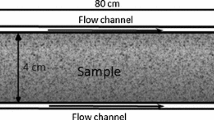Abstract
This paper aims to discuss the applicability of the classical matrix diffusion model against the integrated body of new data obtained by different methodologies on several samples of three granite boulders. The matrix diffusion model was tested against observations from the upper (most weathered in contact with air) and lower (fresh in contact with the ground) part of a boulder block. A U(VI) enrichment up to nearly 300 ppm (compared to about 10 ppm background concentration) mostly as uranophane was observed in the zone between the weathered and fresh rock. U-series disequilibrium studies indicated that most of U has been accumulated recently, about 10 000 years ago [1].
High interconnected porosity (total porosity of > 1% and up to about 5.5% in altered minerals) characterizes the weathered zone (upper part), whereas the maximum porosity values in the fresh zone (lower part) of the rock are about 0.4–0.6%. Stable isotope studies δ18O and δ2H confirm that the mineralogical changes observed in the weathered upper part are due to old hydrothermal events. That is, the alteration is much older than uranium accumulation. Mössbauer spectroscopy showed that the Fe(III) content of the biotites from the upper to the lower part decreases from 30% in the weathered zone to 17% in the fresh rock, thus indicating possible redox control for the observed U precipitation. Fission track studies showed that secondary U(VI) also occurs within minerals grains (especially plagioclase) in the upper part.
Mathematical simulations indicate that matrix diffusion alone is not enough to reconstruct the past U accumulation. The simulated concentrations derived from U concentration in pore water multiplied by Kd are clearly too small, indicating apparent insufficiency of the Kd approach. However, even with only matrix diffusion, the simulations roughly reconstruct the observation that U levels are clearly higher in the upper part of the boulder than in the lower part.
Similar content being viewed by others
References
L. Saarinen & J. Suksi, Report YJT-95-01, 1995.
W.R. Alexander, I.G. McKinley, A.B. MacKenzie & R.D. Scott, in Scientific Basis for Nuclear Waste Management XIII, Mat. Res. Soc. Symp. Proc. 261, Pittsburg, PA, 1990, p. 567–576.
A.G. Latham, Nirex Report NSS/R264, 1991.
K. Rasilainen, VTT Publications 331, 81 p., 1997.
K. Rasilainen, J. Suksi, Hellmuth, K.-H. Hellmuth, A. Lindberg & S. Kulmala, in Scientific Basis for Nuclear Waste Management XIX, edited by W.M. Murphy & D.A. Knecht, Mat. Res. Soc. Symp. Proc. 412, Pittsburg, PA, 1996, p. 855–862.
K.-H. Hellmuth, S. Lukkarinen & M. Siitari-Kauppi, Isotopenpraxis, Isotopes in Environmental and Health Studies, 30, p. 47–60, (1994).
E.Ö. Årmänen, Lic. Thesis, Helsinki University of Technology, 1998.
C. Alves, M.A. Sequeira Braga & C. Hammecker, C. R., Acad. Sci. Paris, 323, p. 397–402, (1996).
B. Allard, F. Karlsson & I. Neretnieks, SKB Technical Report 91–50, (1991).
U. Vuorinen & M. Snellman, Posiva Working Report 98-14, (1998).
C.M. Bethke, The Geochemist’s Workbench Release 3.0, A Users Guide to Rxn, Act2, React, and Gtplot, University of Illinois, Urbana (1998) 184 pp.
F. Chen, R.C. Ewing & S.B. Clark, Amer. Mineral. 84 (1999) 650.
I. Neretnieks, Journal of Geophysical Research, 85, p. 4379–4397 (1980).
Author information
Authors and Affiliations
Rights and permissions
About this article
Cite this article
Marcos, N., Siitari-Kauppi, M., Suksi, J. et al. Discussion on the Use of Matrix Diffusion Model after a Multidisciplinary Study of a Granitic Boulder Sample. MRS Online Proceedings Library 663, 1053 (2000). https://doi.org/10.1557/PROC-663-1053
Published:
DOI: https://doi.org/10.1557/PROC-663-1053



